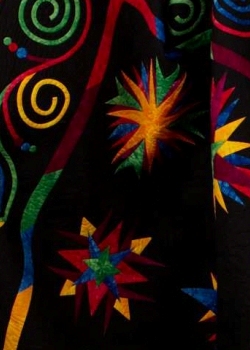Batting has an “up” and “down”
 Well, most of it does, anyway! It may surprise you to know that many batting products have a right side and a wrong side, just like fabric. If you place the batting wrong side up, you’ll typically experience more batting “bearding” (small slubs of batting that pull to the back side of the quilt) or difficulty in maintaining consistent thread tension.
Well, most of it does, anyway! It may surprise you to know that many batting products have a right side and a wrong side, just like fabric. If you place the batting wrong side up, you’ll typically experience more batting “bearding” (small slubs of batting that pull to the back side of the quilt) or difficulty in maintaining consistent thread tension.
The “right side” vs. the “wrong side”
Batting that has been needle punched during its formation has a right side. Look at the batting and search for small pin holes or dimples in the batting. Needle-punching methods drive small needles from one side of the batting to the other as they compress the fibers together. These small holes will reveal the right side of the batting. You want your machine’s needle to penetrate the batting in the same direction as the needle-punching machine.
The wrong side of the batting will have more slubs, which are tiny balls of batting. The wrong side looks much like a sweater that has been worn one too many seasons. If you have this side inadvertently facing up when you layer your quilt, your needle can catch one of these dense little balls of batting and try to force it back through the batting and out the back of the quilt, resulting in bearding.
Examine your batting carefully
For many products, the right side and wrong side will be very apparent. Others may take a little more studying to determine up from down. Sometimes you can tell the right side by trying to insert a pin into the batting from both directions. The pin will often slide through more easily from the right side to the wrong side.
Some very popular products are often placed wrong side up in quilts by accident. For example, Warm and Natural 100% cotton has a “clean side” and a “dirty side” – you’ll notice more small cotton seed flecks on the dirty side. Quilters who don’t know about “up and down” often put the dirty side down, so that the seed flecks don’t shadow through the quilt top. However, this is incorrect! The dirty side is actually the right side of Warm and Natural and should face up when layering the quilt.
Check you needle’s sharpness
If you experience bearding with a batting, and the bearding happens with nearly every stitch, you most likely have a dull or burred needle. However, if you notice only an occasional dot of batting on the back side of your quilt, you may indeed have the batting upside down! Even with right side, wrong side knowledge, you can still have bearding with batting that is particularly dense or “slubby” on the backside.
Some battings do not have any right side
You can identify these battings by their processing. Thermal or resin bonding holds the fibers together differently from needle punching. Batting that has a scrim also has direction. The scrim prevents batting migration through your top. Quilters often debate whether the scrim side goes up or down. If the batting is needle punched, use that as your first choice for deciding direction. If it is bonded, however, place the scrim on the side of the batting which will receive the most wear. A bed quilt, for example, will rub against the sheets every single night. In this case, placing the scrim down will help reduce batting migration.



